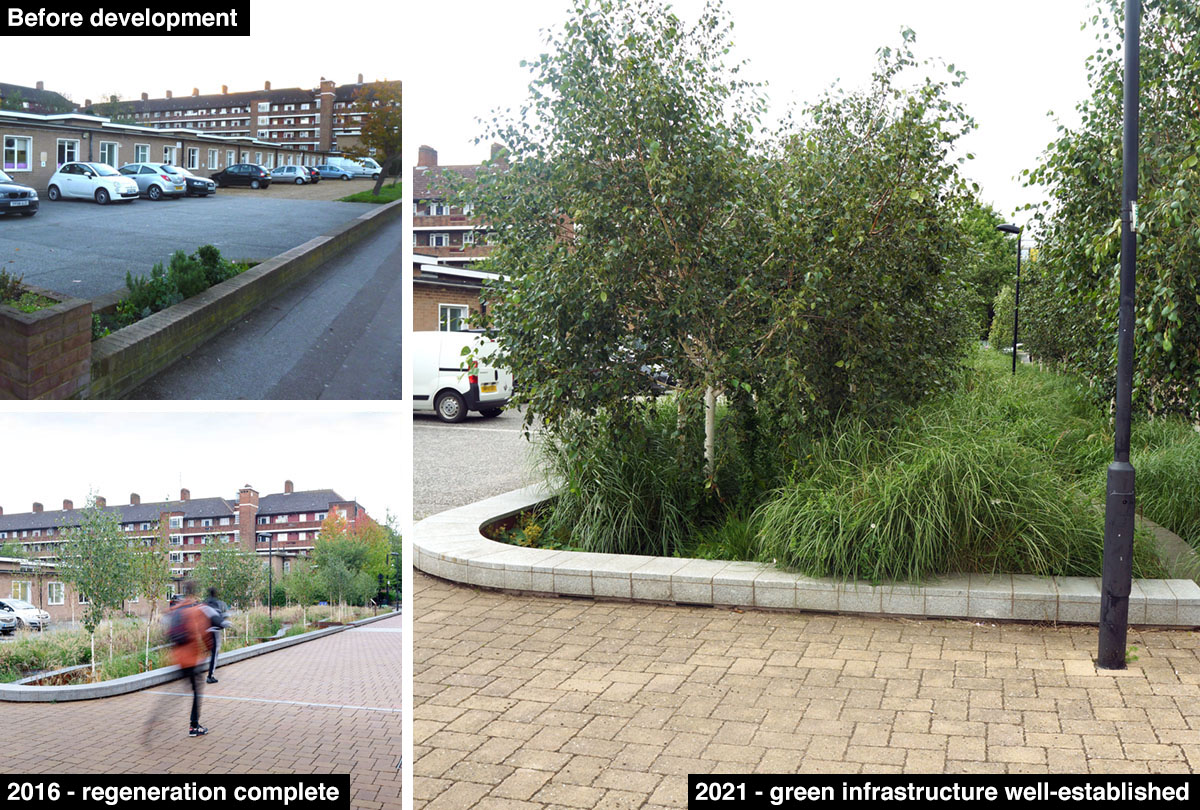Planning Requirements for Trees
The 2021 ‘National Planning Policy Framework’ (NPPF) states: ‘Planning policies and decisions should ensure that new streets are tree-lined and that opportunities are taken to incorporate trees elsewhere in developments’. However, measures are needed to nurture and allow trees to mature and deliver their real potential – including net carbon storage, urban cooling through shading and evapotranspiration, biodiversity and public wellbeing. So, the NPPF also requires that: ‘appropriate measures are in place to secure the long-term maintenance of newly-planted trees’.
Paving and Trees in Harmony
Urban trees and paved surfaces have traditionally been seen as in conflict, creating maintenance problems. But this is not the case with concrete block permeable paving (CBPP), a key sustainable drainage (SuDS) technique designed to reduce flood risk and make cities more liveable. CBPP offers unique opportunities to collect, attenuate and convey rainwater runoff, removing pollutants before irrigating green infrastructure and supporting biodiversity.
Unlike conventional impermeable hard landscape materials, CBPP allows the same pattern of run-off transfer to the ground as natural landscape, allowing water to reach tree and shrub roots, as well as gas exchange for air supply and CO2 escape – all critical to tree growth. Long-term tree maintenance measures will now be included in planning consents and a straightforward spatial solution, such as CBPP, offers a multifunctional solution over the long-term.
Multifunctional Benefits
CBPP can be laid level and still avoids puddles, as well as potholes, without the need for drainage gulleys. It provides a safe surface for everyone – including wheelchair users and people pushing prams. Two decades of experience in the UK demonstrate the long-term performance of CBPP with minimal, if any, maintenance.
Essentially, CBPP technology shares the same impressive performance as conventional modular concrete paving, being slip resistant, durable, strong and sustainable. The difference with CBPP is enlarged joints, filled with a permeable aggregate, and the materials used below the blocks, which are specifically selected to accommodate water. It’s important to remember that CBPP is unlike – and not to be confused with – permeable materials, which behave very differently.
Sustainable Regeneration
As well as new construction, CBPP can be used as an overlay, regenerating and re-using existing, conventional road bases or other hard surfaces – as well as their embedded carbon. These thin overlays create attractive, safe and sustainable shared-surfaces that can supply a gradual flow of clean water horizontally into raingardens or bioretention areas with trees and other green infrastructure, to store water for irrigation, biodiversity and SuDS.

This approach is exemplified in Bridget Joyce Square, London, an important, award-winning regeneration project. Here, a typical, adopted asphalt street and adjacent parking areas were transformed for community use with CBPP overlay shared surfaces and tree-planted raingarden basins – an exemplar for future urban landscapes.
The basins provide water storage for SuDS to reduce overloading existing drains, as well as for irrigation. Interpave revisited the project in August 2021, around 5 years after completion, and noted that trees and other green infrastructure were healthy, substantial and particularly well-established. The permeable paving is also performing well and, it is understood from local sources, experienced no problems during this year’s extreme summer storms, despite extensive flooding nearby.
Download the case study here.
